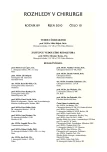Right-Sided Posttraumatic Ruptures of the Diaphragm
Authors:
P. Hromádka; S. Černohorský *; M. Baader; J. Škach; R. Gaalová
Authors‘ workplace:
Chirurgické oddělení, Nemocnice na Homolce, primář: MUDr. M. Toběrný, MBA
; Chirurgické oddělení, Krajská nemocnice Liberec, přednosta: MUDr. M. Baader
Published in:
Rozhl. Chir., 2010, roč. 89, č. 10, s. 638-641.
Category:
Monothematic special - Original
Overview
The diaphragm is the main respiratory muscle. It has the most significant function in respiratory excursions and the ability to maintain the negative thoracic pressure.
Diaphragm injuries are relatively rare and they are the result of blunt or, in our conditions less often, penetrating thoracoabdominal trauma. (The ratio of blunt traumas to penetrating ones is 9:1). The diaphragmatic injuries in blunt injuries occur as a result of the increased pressure gradient between the pleural and peritoneal cavity [1].
The first description of traumatic diaphragm rupture is ascribed to Sennertus from 1541. Other sources award the primacy to the French royal surgeon A. Paré in 1579 [2]. It is similar to the primacy of the surgical repair of diaphragmatic injuries. Rioffi in 1886 [3] versus Naumann in 1888 who operated on traumatic herniation of the stomach into the left chest cavity [2].
Diaphragmatic injury diagnosis is difficult even today [4]; up to 10–50% of cases are not recognized in time.
Left-sided traumatic lesion of the diaphragm occurs in 80–90% of cases. Our paper focuses on the specifics of right-sided diaphragm ruptures where the protective ability of the liver is probably reflected.
Key words:
diaphragm injuries, polytrauma
Sources
1. Küćük, H. F., Demirhan, R., Kurt, N., Ozyurt, Y., Topaloglu, I., Gülmen, M. Traumatic diaphragmatic rupture: analysis of 48 cases. Ulus Travma Derg. Apr 2002; 8(2): 94–97.
2. Asensio, J. A., Petrone, P., Demitriades, D., commentary by Davis, J. W. Injury to the diaphragm. In: Moore, E. E., Feliciano, D. V., Mattox, K. L. Trauma. Fifth Edition, 2003, McGraw-Hill Professional, pp. 613–616.
3. Goh, B. K. P., Wong, A. S. Y., Tay, K.-H., Hoe, M. N. Y. Delayed presentation of a patient with a ruptured diaphragm complicated by gastric incarceration and perforation after apparently minor blunt trauma. CJEM, 2004; 6(4): 277–280.
4. Scharff, J. R., Naunheim, K. S. Traumatic diaphragmatic injurie. Thorac. Surg. Clin., February, 2007, 17 (1): 81–85.
5. Welford, M. Diaphragmatic Injurie. eMedicine, Updated: Oct 21, 2008.
6. Kim, H. H., Shin, Y. R., Kim, K. J., Hwang, S. S., Ha, H. K., Byun, J. Y., et al. Blunt traumatic rupture of the diaphragm: sonographic diagnosis. J. Ultrasound. Med., 1997, Sep; 16(9): 593–598.
7. Mirvis, S. E., Shamuganathan, K. Imaging of thoracic trauma. Magnetic Resonance Imaging Clinics of North America, 2000; 8: 91–104.
8. Petrone, P., Leppaniemi, A., Inaba, K., Soreide, K., Asensio, J. A. Diaphragmatic injuries: challenges in the diagnosis and management. Trauma, 2007; 9: 227–236.
9. Tai, N. R., Boffard, K. D. Thoracic trauma: principles of early management. Trauma, 2003, 5: 123–136.
10. Johnson, C. D. Blunt injuries of the diaphragm. Br. J. Surg., 1988; 7: 226–230
11. Vodička, J. http://www.fnplzen.cz/kliniky/chk/Prednasky/Hrudni/Hrudnik%5CVodicka1.doc
Labels
Surgery Orthopaedics Trauma surgeryArticle was published in
Perspectives in Surgery

2010 Issue 10
Most read in this issue
- Gastrointestinal Metastases of Malignant Melanoma
- Surgical Management of Solid Tumors in the Czech Republic
- Locoregional Recurrences after Conservative Surgery in Early Breast Cancer
- Male Breast Cancer – Our Experience
